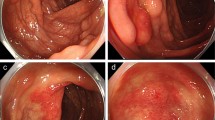Abstract.
Intestinal spirochetosis (IS) is a condition defined morphologically by the presence of spirochetal microorganisms attached to the apical cell membrane of the colonic and rectal epithelium. Intestinal spirochetes comprise a heterogeneous group of bacteria. In humans Brachyspira aalborgi and Brachyspira pilosicoli predominate. Prevalence rates of IS are low where living standards are high, in contrast to poorly developed areas where IS is common. Homosexuals and HIV-infected individuals are at high risk of being colonized. Clinical significance in individual cases has remained unclear up to now. A review of the literature reveals that invasion of spirochetes beyond the surface epithelium is associated with gastrointestinal symptoms which respond to antibiotic treatment (metronidazole), whereas patients lacking this feature are mostly asymptomatic. Homosexual and HIV-positive men are more likely to be symptomatic irrespective of invasion. Rare cases of spirochetemia and multiple organ failure have been reported in critically ill patients.
Similar content being viewed by others
Author information
Authors and Affiliations
Corresponding author
Rights and permissions
About this article
Cite this article
Körner, M., Gebbers, JO. Clinical Significance of Human Intestinal Spirochetosis—A Morphologic Approach. Infection 31, 341–349 (2003). https://doi.org/10.1007/s15010-003-3145-y
Received:
Accepted:
Issue Date:
DOI: https://doi.org/10.1007/s15010-003-3145-y




